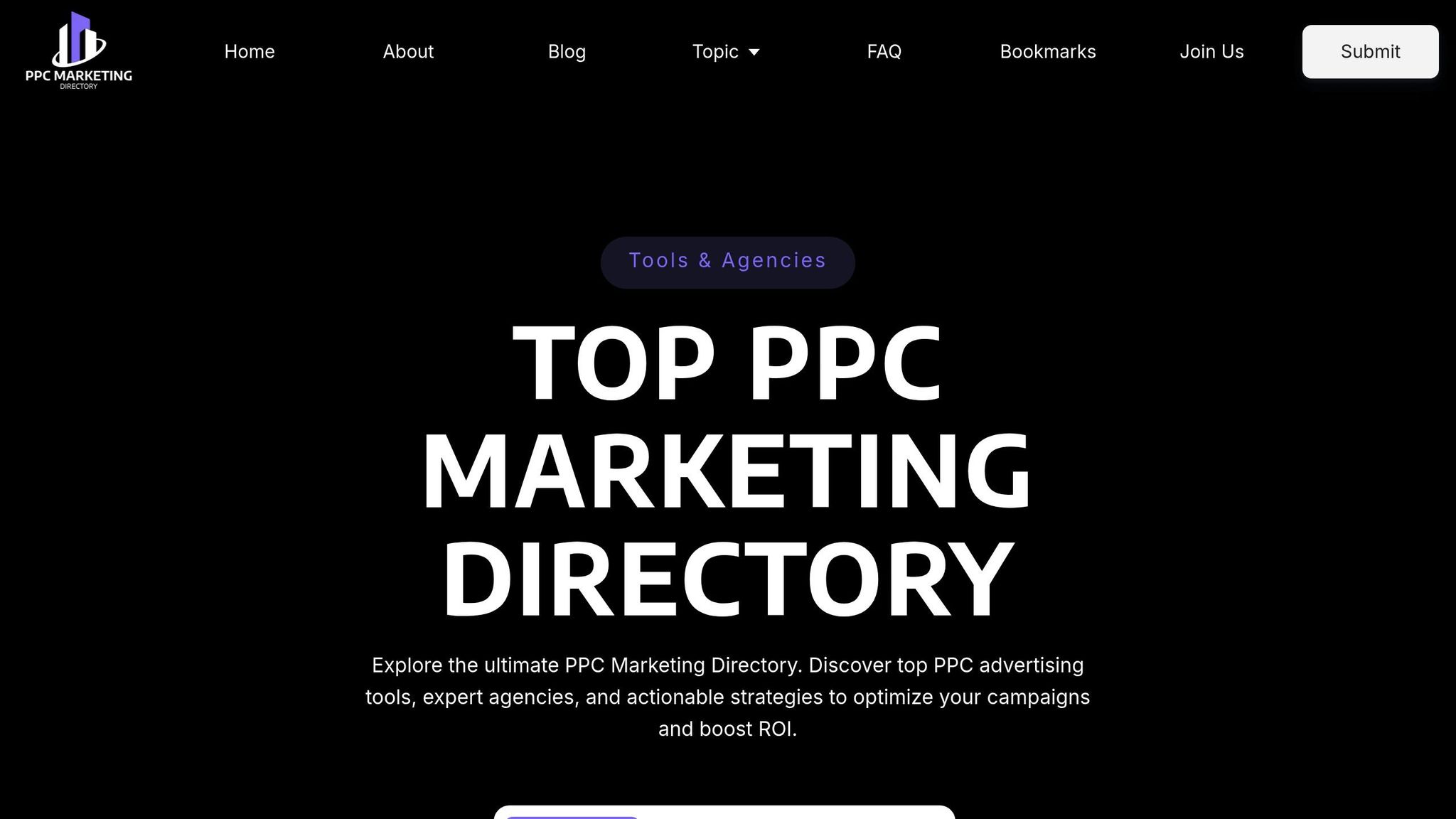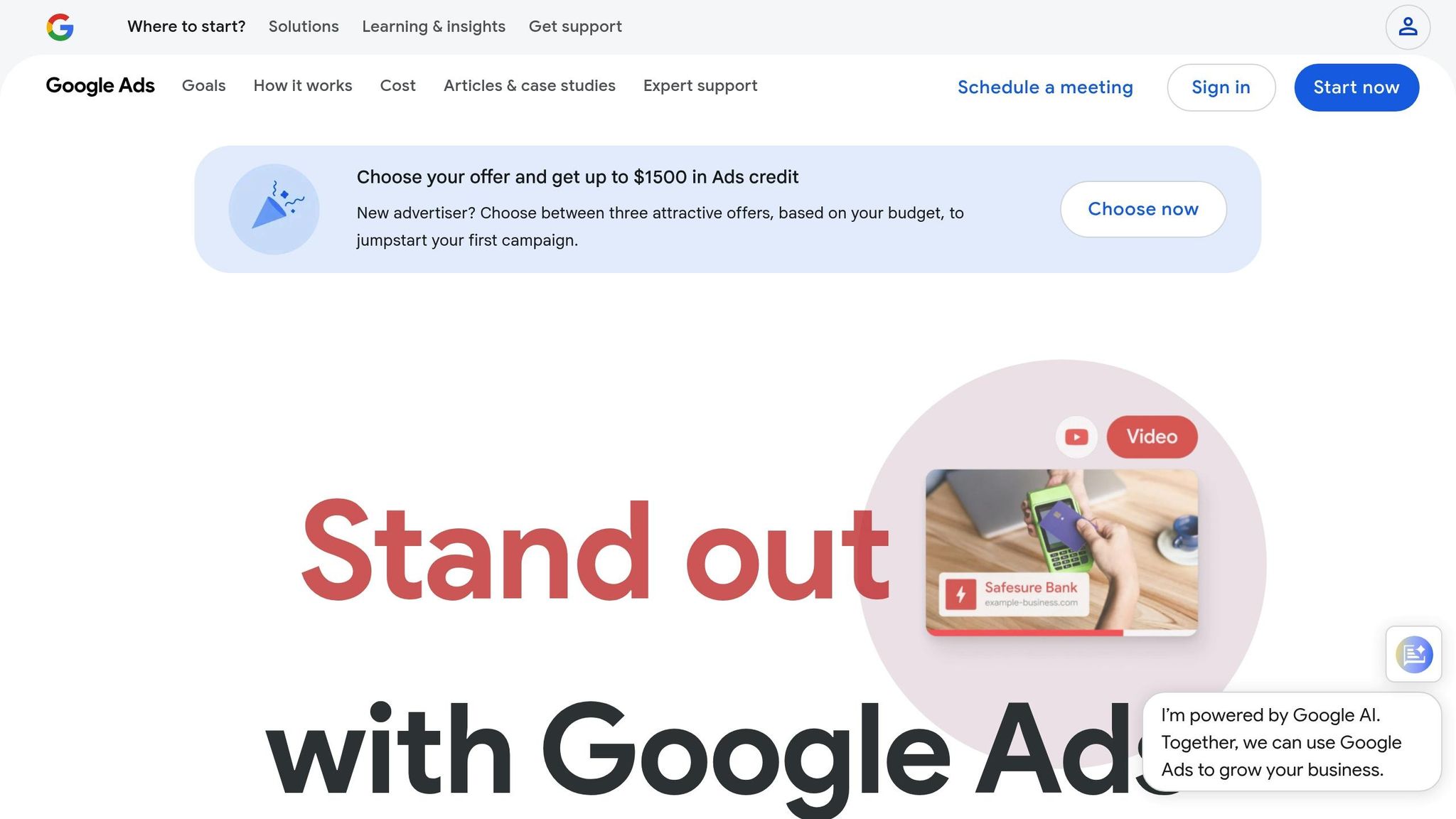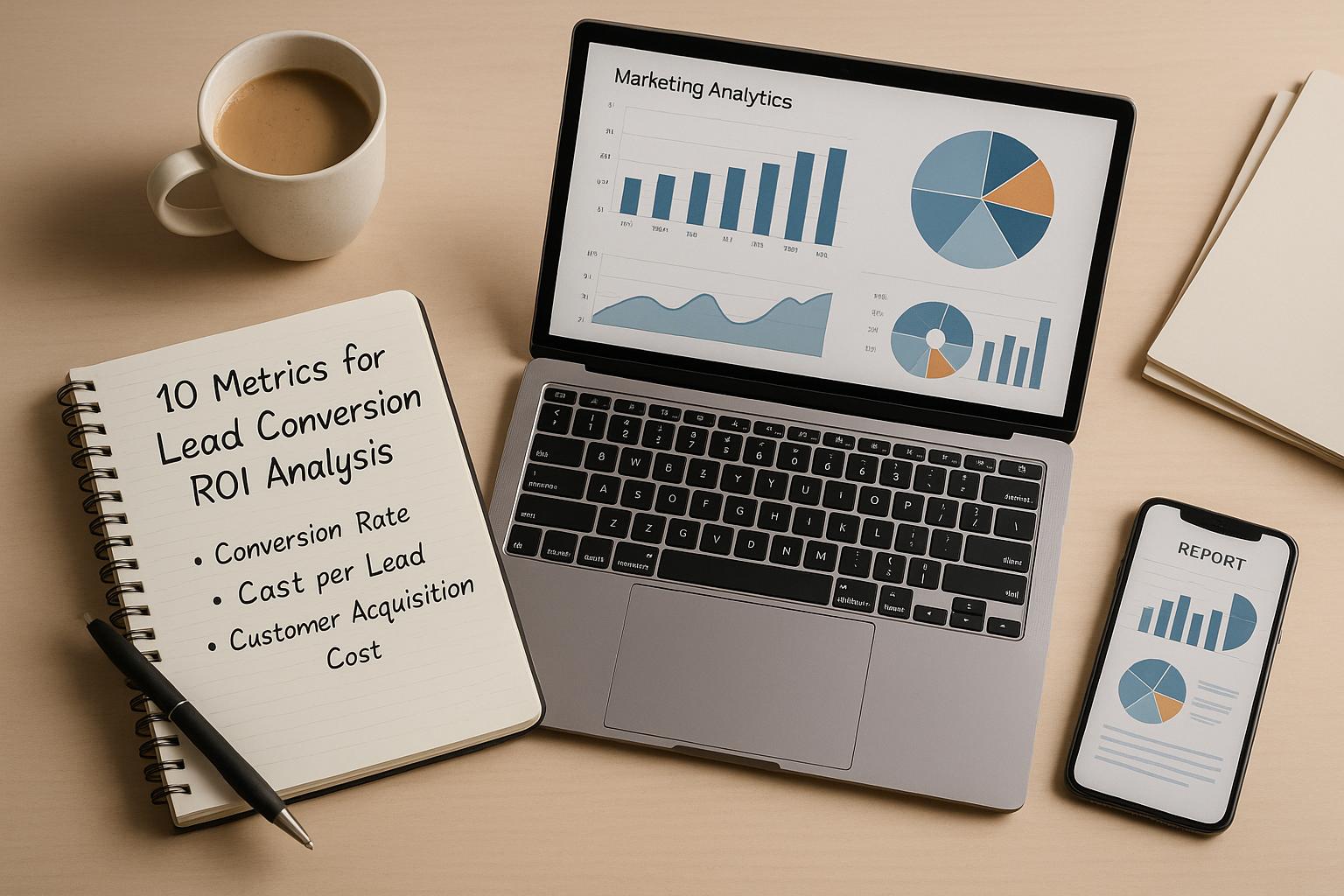When it comes to measuring the success of your PPC campaigns, attribution models play a crucial role in determining which marketing efforts get credit for conversions. Two common models - Position-Based Attribution and Last Click Attribution - take very different approaches to assigning credit across the customer journey:
- Last Click Attribution: Assigns 100% credit to the final touchpoint before a conversion. It's simple and works well for short sales cycles or immediate conversions but ignores earlier interactions.
- Position-Based Attribution: Allocates 40% credit to the first and last interactions, with the remaining 20% distributed across middle touchpoints. This model provides a more balanced view of multi-step journeys but requires more advanced tracking systems.
Key Takeaways:
- Last Click is best for straightforward, single-touch campaigns or quick decisions.
- Position-Based is ideal for longer, multi-channel customer journeys where multiple touchpoints drive results.
Quick Comparison:
| Feature | Position-Based Attribution | Last Click Attribution |
|---|---|---|
| Credit Distribution | 40% to first & last interactions; 20% to middle touchpoints | 100% to the last interaction |
| Best For | Multi-step customer journeys, longer sales cycles | Short sales cycles, single-touch campaigns |
| Pros | Highlights key touchpoints, balances credit | Simple setup, clear insights |
| Cons | May undervalue middle interactions, needs advanced tracking | Ignores early touchpoints, narrow view |
Choosing the right model depends on your business goals, sales cycle length, and customer journey complexity. Both models impact how you allocate budgets, evaluate performance, and optimize campaigns.
How Position-Based Attribution Works
Position-Based Attribution Mechanics
Position-based attribution, often called U-shaped attribution, splits credit across the customer journey by prioritizing the first and last interactions. These two touchpoints are seen as the most influential: the first initiates interest, while the last seals the deal. Here's how the credit is distributed: 40% goes to the first interaction, another 40% to the last, and the remaining 20% is shared among the touchpoints in between.
"Position-based gives 40% of credit to both the first and last ad interactions and corresponding keywords, with the remaining 20% spread out across the other ad interactions on the path." – Google Support
Imagine this scenario: A potential gym member searches for "fitness centers near me" on Google and clicks on a search ad, sparking initial interest. They visit the gym's website, sign up for a newsletter, and later receive an email with a special offer. That email prompts them to sign up for a membership. In this case, the search ad earns 40% of the credit for generating awareness, the email with the special offer gets 40% for driving the conversion, and the website visit and newsletter subscription share the remaining 20%. This structured allocation helps businesses identify which touchpoints play the most critical roles in the customer journey.
Benefits of Position-Based Attribution
Position-based attribution is particularly useful for businesses navigating complex customer journeys.
One of its strengths is providing a balanced perspective. Unlike models that focus entirely on either the first or last interaction, this approach acknowledges the importance of both. By doing so, marketers can optimize their strategies for both brand awareness and conversion-focused efforts, ensuring a more effective allocation of resources.
Another benefit is its straightforward yet insightful design. While it offers a multi-touch view, it avoids the complexity of advanced algorithmic models. This makes it easier to identify major touchpoints while still giving credit to supportive interactions like email clicks, social media engagements, or retargeting ads. It strikes a balance between simplicity and depth, making it accessible while still capturing the nuances of the customer journey.
When to Use Position-Based Attribution
Position-based attribution works best for customer journeys that involve multiple important interactions.
For instance, businesses with long sales cycles - such as B2B software companies, real estate firms, or sellers of high-ticket consumer goods - can benefit greatly from this model. These industries often involve extensive research and multiple touchpoints before a purchase is made. Similarly, campaigns that span multiple channels, like Google, Facebook, email, and display ads, can use this approach to better understand how these platforms contribute to the overall journey.
However, this model may not be ideal for campaigns where customers convert immediately after their first interaction or when only a single touchpoint is involved. In such cases, simpler attribution models might offer more clarity.
How Last Click Attribution Works
Last Click Attribution Mechanics
Last click attribution assigns 100% of the conversion credit to the final marketing touchpoint - whether that's a search ad, display banner, or email campaign.
Here’s how it works: when a customer completes a conversion, the system gives full credit to the last interaction, completely ignoring earlier touchpoints. For example, imagine a customer clicks on multiple ads over time but ultimately converts after engaging with a retargeting ad. In this case, the retargeting ad receives all the credit for the conversion.
This model assumes the last interaction was the key driver behind the conversion. It’s a straightforward way to identify which campaigns are directly tied to final conversions. Historically, platforms like Google Analytics have used last click attribution as their default model, though many are now shifting toward more advanced alternatives.
Benefits of Last Click Attribution
One of the biggest advantages of last click attribution is its simplicity. It requires very little setup and provides quick insights. For businesses looking for immediate, actionable data, this approach can be appealing.
This model is particularly effective for short sales cycles or single-session conversions. When customers make decisions quickly - like purchasing a product immediately after discovering it - last click attribution provides an accurate reflection of the conversion process. It’s also a good fit for performance marketing campaigns that rely on fast conversions.
Drawbacks of Last Click Attribution
Despite its simplicity, last click attribution has some serious flaws that can lead to poor marketing decisions. By focusing solely on the final touchpoint, it completely ignores earlier interactions that may have heavily influenced the customer’s decision.
"Last-click attribution is a simplistic and outdated way to measure marketing effectiveness. It gives all the credit to the last touchpoint in the customer journey, even though many other touchpoints may have contributed to the conversion."
– Avinash Kaushik
This narrow view can result in misallocated marketing budgets, as it undervalues channels that build brand awareness or foster engagement. For instance, if a customer first learns about a brand through a social media ad, interacts with several other campaigns, and finally converts via a search ad, last click attribution would give no credit to the earlier touchpoints. This could lead to reduced investment in channels that play a crucial role in the early stages of the customer journey.
As customer journeys become more complex, the shortcomings of this model become even more pronounced.
"Last-click attribution is like giving a marathon runner a medal for only crossing the finish line. It ignores all the hard work that went into getting there."
– Chris Goward
"Last click has long been the industry standard, but as customer journeys become more complex, it's no longer enough alone to justify spending or measure performance."
– Katie Rigby
Recognizing these limitations, even Google has moved away from last click attribution as the default in Google Ads, opting instead for data-driven attribution models. This shift reflects a broader trend: around 75% of companies now rely on multi-touch attribution to get a more accurate picture of the customer journey. Unlike last click, these models capture the full range of interactions that contribute to a conversion, offering a more comprehensive view of marketing effectiveness. This growing preference for multi-touch attribution highlights the need to move beyond single-touch models like last click.
Position-Based vs Last Click Attribution Comparison
Main Differences Between the Models
Let’s break down how position-based and last click attribution differ in valuing touchpoints, handling complexity, and assessing channel contributions.
Last click attribution gives 100% credit to the final touchpoint before a conversion. In contrast, position-based attribution spreads the credit - 40% to the first and last interactions and 20% to all others in between, as explained earlier. While last click attribution is straightforward and easy to implement, position-based attribution demands more advanced tracking systems to function effectively.
When it comes to evaluating channels, last click attribution often undervalues those that initiate the customer journey, like display ads or social media campaigns that build early awareness. On the other hand, position-based attribution ensures every touchpoint gets some credit, painting a fuller picture of how different channels contribute to conversions.
Another key difference is reliability in complex tracking scenarios. Last click attribution tends to hold up better when tracking is disrupted by device switching or cookie deletion.
The models also cater to different types of purchase behaviors. Last click attribution works well for quick, impulse-driven purchases or short decision-making cycles. Position-based attribution, however, is better suited for longer, more complex customer journeys involving multiple stages of research and interaction.
Pros and Cons of Each Model
| Feature | Position-Based Attribution | Last Click Attribution |
|---|---|---|
| Pros | Highlights key touchpoints, values intermediate interactions, provides a multi-touch perspective | Easy to implement, clear and actionable for immediate campaigns |
| Cons | May overemphasize first and last interactions, requires advanced tracking, could undervalue middle touchpoints | Overlooks early touchpoints, neglects multi-channel contributions, offers a limited view |
| Ideal Use Cases | Multi-step customer journeys, short to medium sales cycles, lower-cost transactions | Single-touch campaigns, immediate conversions, short sales cycles |
Position-based attribution excels at offering a broader view of the customer journey, crediting both the initial awareness-building activities and the final conversion-driving touchpoints. However, it can sometimes overvalue the first and last interactions, leaving critical middle-stage touchpoints underappreciated. This is particularly problematic for businesses with complex sales funnels that rely on nurturing prospects through multiple stages.
Last click attribution, by contrast, thrives on simplicity. It provides clear, actionable insights for campaigns focused on driving immediate results. However, its narrow lens creates blind spots, ignoring earlier interactions that often play a vital role in building awareness and sparking initial interest.
Grasping these strengths and weaknesses is essential for making informed decisions about budget allocation and campaign optimization.
Impact on Budget and Campaign Performance
The way these models allocate credit has a direct impact on how marketing budgets are spent and how campaigns perform. Last click attribution often leads to over-investment in channels closely tied to final conversions, such as branded search campaigns or retargeting ads. This can result in underfunding channels like display ads or social media, which are critical for creating awareness at the top of the funnel.
Position-based attribution provides a more balanced approach to budget allocation. By recognizing the value of both awareness-building and conversion-driving activities, it helps marketers avoid the trap of cutting funding for upper-funnel efforts that, while not immediately impactful, are essential for nurturing qualified prospects.
Switching from last click to multi-touch attribution models can increase conversions by 6-8% without raising costs. Accurate attribution also helps marketers allocate budgets more effectively, pinpointing which parts of their PPC campaigns deliver the best results. With position-based attribution, marketers gain a comprehensive understanding of the customer journey, enabling them to design experiences that not only drive immediate conversions but also build long-term loyalty. This broader perspective allows businesses to see how various campaigns work together, rather than viewing each channel in isolation.
Choosing the Right Attribution Model
Factors to Consider When Selecting a Model
Picking the best attribution model isn’t a universal process - it depends on your business and its unique needs. As Johanna Abegail Vargas from Optimind Technology Solutions puts it, "Choosing the right attribution model for your PPC campaigns is key to understanding customer behavior, optimizing spend, and pinpointing improvement areas".
For businesses with short sales cycles, simpler models like last-click attribution can work well. However, if your customer journey is longer and more intricate, a multi-touch model such as position-based attribution might better reflect your marketing efforts.
Your marketing channel mix also plays a big role. If you’re only running campaigns on a few channels, single-touch models might suffice. On the other hand, businesses using multiple channels - like social media, email, display ads, and content marketing - are better off with multi-touch models to capture the full picture.
The complexity of your business model is another key factor. For instance, e-commerce stores selling low-consideration items may find last-click attribution sufficient. Meanwhile, B2B companies with lengthy sales cycles and multiple decision-makers typically benefit from position-based models, which offer a broader view of the journey.
Finally, think about your business goals. If you’re focused on customer acquisition, first-touch attribution highlights which channels bring in new leads. For optimizing conversions and identifying what seals the deal, last-click attribution is often more effective.
By keeping these factors in mind, you can avoid many common attribution pitfalls.
Common Attribution Mistakes to Avoid
Marketers often stumble into predictable traps when working with attribution models. One of the biggest mistakes is oversimplifying complex customer journeys. For example, relying solely on last-click attribution for high-consideration products can lead to underfunding awareness-building efforts that are critical for long-term growth.
Another common issue is neglecting your tracking capabilities. Advanced models like position-based attribution require strong systems that can handle cross-device tracking and adapt to privacy regulations. Without these systems, the data you gather may be incomplete or unreliable.
Failing to test different models is another misstep. Sticking to one approach can mean missing out on valuable insights. Marketers who experiment with multiple models often uncover gaps between initial engagement and final conversion that would otherwise go unnoticed.
Misaligning the attribution model with your campaign goals can also create confusion. For instance, using a conversion-focused model to evaluate a brand awareness campaign can lead to misleading conclusions.
Lastly, don’t make the mistake of setting and forgetting your attribution model. Customer behaviors evolve, and new channels emerge. What worked six months ago might no longer align with your current priorities.
Matching Attribution to Business Goals
Once you’ve sidestepped the common pitfalls, it’s time to align your attribution model with your business objectives. The model you choose should directly support your goals. For example, if you’re focused on brand awareness, first-click attribution can show which channels are most effective at capturing attention.
If you need insights into the entire customer journey, multi-touch models like linear or position-based attribution can help you see how various touchpoints contribute to conversions.
Before settling on a model, take a close look at your campaign strategy and tracking capabilities. While advanced models can provide deeper insights, they also require a solid tracking infrastructure and analytical know-how.
Keep monitoring and analyzing your campaigns across different models. The aim isn’t to find a “perfect” model - it’s to choose the one that aligns with your current goals and delivers actionable insights for continual improvement.
sbb-itb-89b8f36
Tools and Resources for Attribution Success
Finding Attribution Tools with Top PPC Marketing Directory

To nail down accurate attribution, you need the right tools. But with so many options out there, how do you choose? That’s where Top PPC Marketing Directory steps in. This platform is like your personal shopper for attribution and performance tracking tools. It brings together a wide range of PPC tools, expert agencies, and services to help you find the perfect match for your business needs. Whether you’re after campaign management software, performance trackers, or specialized attribution platforms, this directory offers detailed comparisons to guide your decision-making. Plus, it aligns perfectly with the multi-touch strategies we’ve already covered.
The directory doesn’t just list tools - it gives you the full picture. You’ll find real-time performance tracking, bid management, and analytics tools, all designed to sharpen your attribution insights. Each listing comes with key details like features, pricing, and user reviews, so you can make informed choices.
Some standout tools include GA4 for event tracking, Analytify for WordPress integration, and Semrush for keyword analysis. If you’re looking for AI-powered solutions, Optmyzr is great for streamlining PPC management. Running campaigns across multiple platforms? Third-party tools like Triple Whale, Northbeam, Rockerbox, and Wicked Reports provide the cross-channel visibility that native solutions often lack. Another option to consider is Usermaven, a marketing attribution platform that consolidates data from various channels, giving you a clear view of your customer journey and how different touchpoints perform. This kind of overview is essential when comparing position-based models to last-click attribution across multiple channels.
Improving PPC Campaigns with Directory Solutions
The real power of the directory lies in its ability to help you compare tools that directly impact your ROI and campaign performance. Considering that businesses typically earn $2 for every $1 spent on ads, picking the right attribution tools can make or break your profitability.
Focus on tools that let you compare different attribution models. For example, Google’s "Model comparison" report is a fantastic feature for analyzing how various models influence your campaign performance and budget decisions. Real-time tracking and automated optimization features are also must-haves, and the directory makes it easier to find platforms that deliver these capabilities.
Here’s a stat to think about: only 17% of advertisers evaluate their channels holistically, yet 52% of those using multi-touch attribution report greater satisfaction with tracking their ad spend. That’s a huge opportunity for businesses willing to invest in comprehensive attribution solutions.
Take ThriftBooks as an example. After adopting 7-day click and 1-day view attribution settings, they saw a 50% jump in average order value and a 35% boost in click-through rates. That’s the kind of success the right tools can help deliver.
The directory also helps you tackle common attribution challenges. With the average cost per click climbing 12.88% year-over-year and 65% of industries seeing better conversion rates, accurate attribution is more important than ever for managing your ad spend effectively. Many tools listed in the directory offer cross-device tracking and adhere to privacy standards, ensuring your data is both reliable and compliant.
Whether you’re diving into position-based attribution for the first time or moving away from last-click models, this directory has you covered. From basic tracking tools to advanced AI-powered platforms, you’ll find solutions that fit your budget, technical needs, and business goals. Armed with these resources, you can fine-tune your PPC campaigns and take your attribution strategies to the next level.
Key Takeaways on Attribution Models
Model Differences and Use Cases Summary
Position-based and last-click attribution take very different approaches to assigning credit during the customer journey. Last-click attribution gives all the credit to the final interaction before conversion, while position-based attribution divides credit - 40% each to the first and last touchpoints, with the remaining 20% spread across other interactions. While simple, these models can overlook the complexity of customer journeys.
"An attribution model is the rule, or set of rules, that determines how credit for sales and conversions is assigned to touchpoints in conversion paths." - Google
Switching between attribution models can drastically alter your insights. For example, an ecommerce client selling high-end products discovered that 25% of their conversions and 19% of their revenue occurred more than 12 days after the initial interaction. This delay highlights the shortcomings of last-click attribution for businesses with longer sales cycles, as it dismisses the importance of early touchpoints.
Position-based attribution often provides a more balanced view. In one case study, switching to position-based attribution led to a 21% increase in non-brand conversion rates. This is because it acknowledges the role of awareness-focused campaigns, which might not generate direct conversions but are vital in guiding customers through the sales funnel.
Last-click attribution is best suited for businesses with short, straightforward sales cycles where customers make quick decisions after their first interaction. It’s also ideal for teams looking for simple reporting and minimal analysis.
Position-based attribution, on the other hand, is more effective for businesses with longer, more complex sales cycles involving multiple touchpoints. It’s particularly helpful for campaigns that include both brand and non-brand efforts, as it prevents over-crediting branded terms that naturally appear closer to the point of conversion.
Choosing the right model depends on your campaign objectives and the complexity of your customer journey.
Final Thoughts on PPC Attribution
When deciding on an attribution model, align it with your business goals and metrics. There’s no one-size-fits-all solution. Factors like your sales cycle length, the number of touchpoints in your customer journey, and your focus - whether on new customer acquisition or immediate ROI - should guide your choice. For businesses prioritizing new customer acquisition, position-based attribution often provides deeper insights. Meanwhile, last-click attribution is better suited for maximizing short-term ROI from bottom-funnel activities.
Switching attribution models can lead to more efficient budget allocation and improved campaign strategy. Businesses have reported a 6-8% increase in conversions without additional costs after making the switch. This improvement stems from more accurate performance tracking and smarter budget distribution.
Keep in mind that changing attribution models will redistribute credit across your campaigns. For instance, moving from last-click to position-based attribution may cause brand conversions to decrease slightly, while non-brand campaigns gain more recognition. This shift better reflects the true contribution of each campaign type.
To get the most out of your attribution model, use tools that support cross-platform tracking, automated bidding, and detailed reporting. Resources like the Top PPC Marketing Directory can help you implement and refine the model that fits your needs.
Start testing new attribution models at the beginning of a month to ensure clean data collection. Avoid making major changes to your account during the testing period, and carefully evaluate how the new model impacts your ROI before committing fully. With the right tools and strategy, you can significantly improve how you measure and optimize your PPC campaigns for long-term growth.
Google Ads Attribution Models - Model Comparisons GA4 [Lesson 6]

FAQs
What makes position-based attribution a more balanced approach to tracking the customer journey compared to last-click attribution?
Position-based attribution offers a more balanced way to assess the customer journey by distributing credit across several touchpoints. It places substantial emphasis on the first and last interactions while still recognizing the middle steps that help guide the customer. This method highlights the importance of both the initial connection and the final conversion, as well as the interactions that support the journey in between.
On the other hand, last-click attribution zeroes in exclusively on the final touchpoint. While simple, this approach can miss the bigger picture of how customers engage with your campaign over time. Position-based attribution gives marketers a clearer view of how each interaction plays a role in driving conversions, making it a smart choice for fine-tuning PPC campaigns.
What challenges do businesses face when using position-based attribution models?
Position-based attribution models can be tricky for businesses to implement successfully. One major hurdle is tracking customer journeys that span multiple channels, especially when offline interactions come into play. These offline touchpoints can complicate efforts to get a clear picture of how different channels contribute to conversions.
Another issue is the complexity of the model itself. Accurately distributing credit across various touchpoints often requires sophisticated tools and a high level of expertise, which can demand significant resources. On top of that, if the data isn't closely monitored, businesses run the risk of misallocating their marketing budgets due to inaccurate attribution insights.
That said, when executed properly, position-based models can shed light on how paid marketing efforts are performing, helping businesses make more informed decisions.
Why would a business switch from last-click attribution to position-based attribution, and how could this affect their marketing strategy?
A business might opt for position-based attribution to better reflect the influence of multiple touchpoints in a customer's journey. Unlike last-click attribution, which assigns all the credit to the final interaction, position-based attribution spreads the credit more evenly. It typically emphasizes both the first and last interactions while also acknowledging the importance of mid-funnel activities.
This shift can reshape a marketing strategy by providing a clearer picture of how various channels contribute to conversions. It pushes businesses to allocate resources more effectively, including investing in areas like awareness or consideration campaigns that might otherwise be overlooked. The result? Smarter spending and stronger campaign performance.


